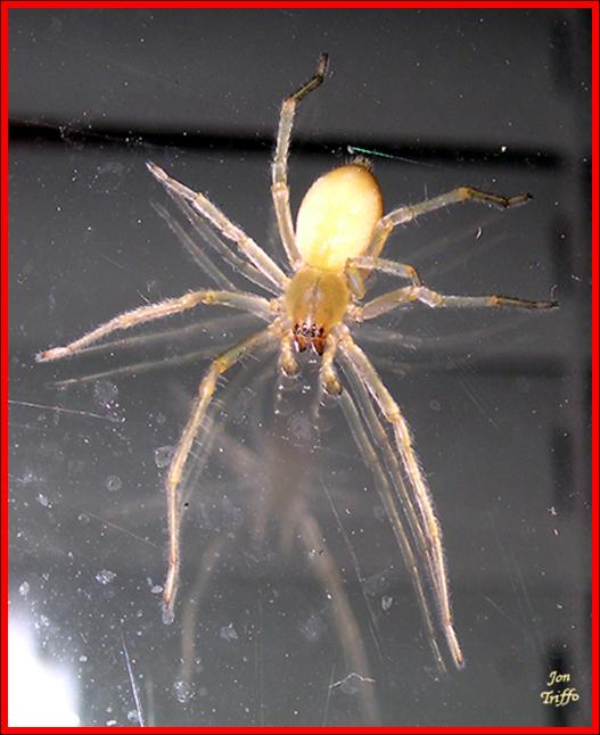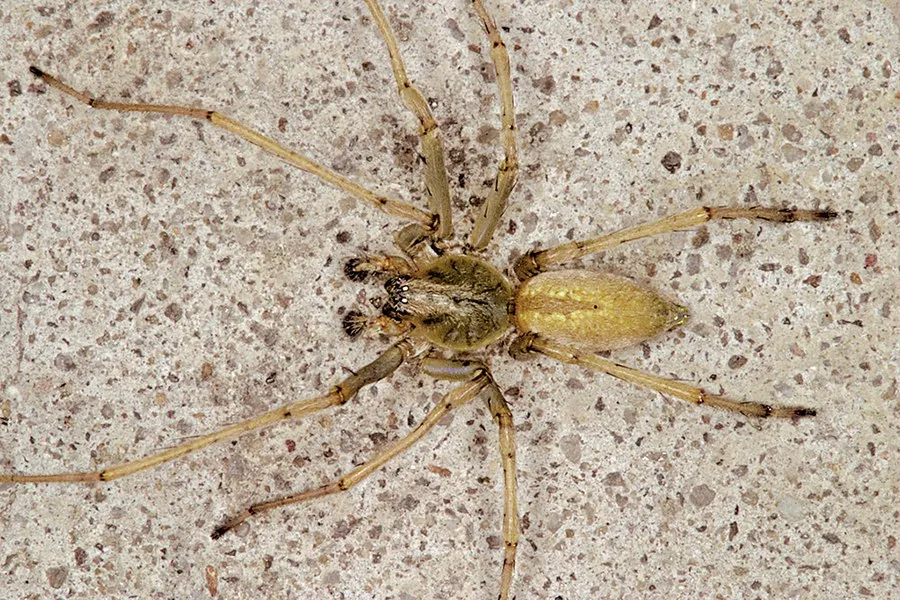These spiders are free-living arachnids frequently encountered among vegetation and within domestic settings, where they construct silken retreats—small sacs beneath which they conceal themselves or deposit their eggs. Their coloration ranges from cream-white and pale yellow to reddish-brown, often marked by distinctly dark or black mouthparts. Although there remains some contention, it is now broadly accepted that these spiders possess cytotoxic venom. Envenomation may result in localized tissue damage, and such wounds should be managed as open injuries. Should the site become necrotic or septic, prompt hospitalization and a course of prophylactic antibiotics is advisable. Importantly, there are no documented fatalities attributed to this species.

Introduction
Sac spiders are widely distributed across Australia, inhabiting both forested and grassland ecosystems.
Identification
Slender Sac Spiders craft small cylindrical or ovoid silken retreats. They exhibit elongated bodies, pronounced chelicerae, and long, slender legs, with males being notably more gracile. Their coloration typically spans cream, brown, or yellow tones, often accompanied by a dark longitudinal stripe on the dorsal abdomen. Male specimens possess especially enlarged jaws.
Stout Sac Spiders, by contrast, feature more robust legs and a cylindrical, muscular build. Their bodies are reddish-brown to fawn, frequently displaying chevron-like patterning on the abdomen.
Habitat
Slender Sac Spiders are agile hunters, commonly observed on foliage within bushland and gardens. They construct their retreats by folding leaves or grass blades but may also inhabit human dwellings, favoring corners of walls and ceilings. Stout Sac Spiders, while occasionally found on walls and fences, are predominantly located beneath bark or within leaf litter. Their sheet-like silk retreats are characteristically found under bark.
Distribution
Sac spiders are broadly distributed across Australia, where they occupy both forest and grassland environments.

Life Cycle
Female sac spiders deposit eggs within their silken retreats and remain nearby to guard them against predation.
Medical Significance
Bites from sac spiders are relatively uncommon and generally induce mild symptoms, such as localized pain and swelling. In rarer cases involving Cheiracanthium species, envenomation may result in headache, nausea, and minor skin ulceration, although such reactions are seldom reported in Australia.
Medical evaluation is recommended if symptoms persist or worsen.
Yellow Sac Spiders (Cheiracanthium inclusum and C. mildei)
Extracted from the Pennsylvania State University Department of Entomology resource: “Commonly Encountered Pennsylvania Spiders (and two rarely encountered but medically important species).”
Yellow sac spiders are frequently found traversing foliage, beneath leaf litter, stones, and boards, as well as on and within buildings—especially around window sills, siding, and interior corners of walls and ceilings. These spiders are likely responsible for more human bites than any other species and are often misidentified by healthcare professionals as brown recluse spiders.
C. inclusum is native to most of the United States (excluding the far northern regions), while C. mildei, an introduced European species, has established populations across the northeastern United States and has likely expanded its range considerably since its initial documentation in 1978.

Morphological Description
Both species are comparable in size—females ranging from 5–10 mm and males from 4–8 mm. C. inclusum exhibits a pale yellow to cream coloration, with dark brown chelicerae, palps, and tarsi. C. mildei shows a slight greenish tint on the abdomen and a pale yellow cephalothorax. Both possess a subtle, darker dorsal stripe extending along the abdomen.
Their silken retreats—narrow tubes or sacs—are discreet and often blend with light-colored interiors, making them difficult to detect.
Life History
Egg-laying occurs in early summer, typically June or July. Eggs are loosely encased within a silken retreat, and the female remains to guard them. C. inclusum is more frequently encountered outdoors, depositing eggs beneath leaves or on foliage, while C. mildei is predominantly indoor-dwelling, laying eggs almost exclusively within human-made structures. Juvenile spiders often remain within the retreat briefly before venturing out nocturnally to forage, returning at dawn to conceal themselves again.
Yellow sac spiders are active predators, hunting rather than ensnaring prey in webs. Human encounters typically occur during these nocturnal excursions, especially when the spider is trapped between skin and clothing, bedding, or footwear.
Medical Importance
Yellow sac spiders are likely responsible for the majority of medically reported spider bites. Bites from C. inclusum tend to produce more severe reactions than those from C. mildei. Most C. inclusum bites occur outdoors during summer gardening activities. C. mildei, though smaller, readily bites and has been observed doing so without provocation, often while traversing human skin.
Fortunately, most bites are benign, producing only transient discomfort. However, in some individuals—particularly those bitten by C. inclusum or sensitized to C. mildei—symptoms can be more pronounced. These include immediate pain, followed by erythema, edema, and pruritus. A burning sensation may persist for up to an hour, with rash and blistering developing within 1 to 10 hours. In rare cases, systemic symptoms such as fever, malaise, muscle cramps, and nausea may occur, resembling but less severe than those caused by Latrodectus (black widow) envenomation. Localized necrosis and ulceration can occur but rarely lead to permanent scarring.
Yellow Sac Spiders: What You Should Know
The vividly colored yellow sac spider is a potentially harmful arachnid commonly found throughout the United States. Although small—rarely exceeding the size of a nickel—this spider delivers a painful bite that can trigger additional symptoms. Often invading homes and other man-made structures, it is important to understand how to identify these spiders, the risks they pose to health, and how to treat and prevent encounters.
What Is the Yellow Sac Spider?
Belonging to the family Clubionidae, the yellow sac spider is a nocturnal member of a group known for spinning sac-like retreats where they rest during the day. These spiders are capable of constructing a new silken cocoon within 10 to 15 minutes, typically suspending it in the corners of rooms or on vegetation such as tree branches.

Identification: What Do Yellow Sac Spiders Look Like?
The appearance of yellow sac spiders varies slightly by species. Cheiracanthium inclusum generally exhibits a pale yellow or cream-colored body, whereas Cheiracanthium mildei features a greenish abdomen and a yellow cephalothorax.
Both species possess brown chelicerae, darker legs, and a distinct dark dorsal stripe along the abdomen. Their eight eyes are arranged in two horizontal rows.
Females typically measure between 5 and 10 millimeters, while males range from 4 to 8 millimeters and tend to be darker and more slender. The presence of scopulae—dense tufts of hair on their feet—enables them to climb efficiently and hunt across foliage, trees, and man-made surfaces.
Diet and Feeding Behavior
Primarily insectivorous, yellow sac spiders prey upon other spiders and small arthropods such as cotton plant bugs, fruit flies, fleahoppers, and leafhoppers. They have also been observed consuming nectar during foraging.
Interestingly, their diet may influence their coloration. Studies have shown that consuming red-eyed fruit flies can give the spider a reddish hue, while feeding on green caterpillars may result in a greenish tint.
Unlike many web-building species, yellow sac spiders actively hunt their prey at night rather than ensnaring it in webs. This nocturnal hunting behavior increases the likelihood of human encounters.
Do Yellow Sac Spiders Jump?
Despite their agility, yellow sac spiders do not jump. Instead, they move rapidly across ceilings, walls, and vegetation. When startled, they may drop a silk thread to escape.
Life Cycle
Female yellow sac spiders typically lay eggs approximately two weeks after mating. The eggs are encased in a silken cocoon, which the female diligently guards until hatching. C. inclusum usually lays eggs outdoors under foliage, whereas C. mildei prefers indoor locations.
After hatching, the spiderlings remain within the cocoon during daylight and begin hunting at night. They emerge from the cocoon after about 17 days. A single female may produce up to five generations, although the average output is two egg masses.
Males reach maturity at around 119 days, while females mature slightly later, at 134 days. Environmental conditions such as humidity and temperature significantly influence developmental rates.
Species of Yellow Sac Spiders
There are two primary species of yellow sac spiders in the United States:
- Cheiracanthium inclusum: Native to most regions of the U.S., this species is commonly encountered outdoors, particularly during warm weather.
- Cheiracanthium mildei: An introduced species from Europe, likely arriving in the 1940s. It is more commonly found indoors compared to C. inclusum.
A third species, Cheiracanthium punctorium, is native to central Europe. Its spiderlings are capable of ballooning—using silk threads to travel long distances through the air. Like its American counterparts, this species matures in spring, reproduces in summer, and dies in winter.
Habitat and Distribution
C. inclusum is widely distributed across the U.S., while C. mildei was initially discovered in northeastern states. Its current range is believed to have expanded considerably.
C. punctorium has spread throughout central Europe since the mid-20th century, now present in the Baltic states, northern Germany, and southern Sweden.
Yellow sac spiders are among the most frequently encountered arachnids by humans. They are commonly seen indoors or in gardens, and researchers believe they may account for more human spider bites than any other species.
With their pale yellow coloration and diminutive size, they often go unnoticed until they construct their characteristic silk sacs. Fast-moving and elusive, they typically reside in leaf litter or sheltered indoor spaces.
Ecological Role and Human Interaction
While the American yellow sac spider (C. inclusum) thrives in natural habitats, C. mildei has adapted well to urban environments. Despite their ecological importance in controlling pest populations, yellow sac spiders are not without risk. They are known to bite when provoked, although such bites rarely lead to serious complications.
Reproductive Behavior
Agrarian yellow sac spiders lay eggs in June or July. The egg sacs, loosely enclosed in silk, are guarded by the female. C. inclusum tends to oviposit on the undersides of leaves, while C. mildei typically lays eggs indoors.
The spiderlings initially remain in the retreat during daylight and venture out at night to hunt, often returning at dawn to seek shelter.
These spiders are active hunters, not passive web-dwellers. Most human encounters—and resulting bites—occur at night when the spiders are foraging and become trapped between skin and bedding, clothing, or footwear.
Medical Significance
Both C. inclusum and C. mildei are responsible for a significant number of reported spider bites in North America. Bites from C. inclusum often occur outdoors during gardening, while C. mildei is known to bite without provocation, sometimes while crawling across exposed skin.
Though usually not medically serious, the bite can be intensely painful, characterized by burning, redness, swelling, and severe itching. The burning sensation may persist for an hour or more, followed by rash and blistering within 10 hours. In rare cases, systemic symptoms such as fever, malaise, muscle cramps, and nausea may occur.
While previously believed to cause necrotic lesions, recent studies involving verified cases have failed to confirm this association, dispelling much of the concern regarding their long-term medical impact.
Understanding the biology and behavior of yellow sac spiders can help reduce the risk of bites and support informed decisions about pest control and coexistence.
